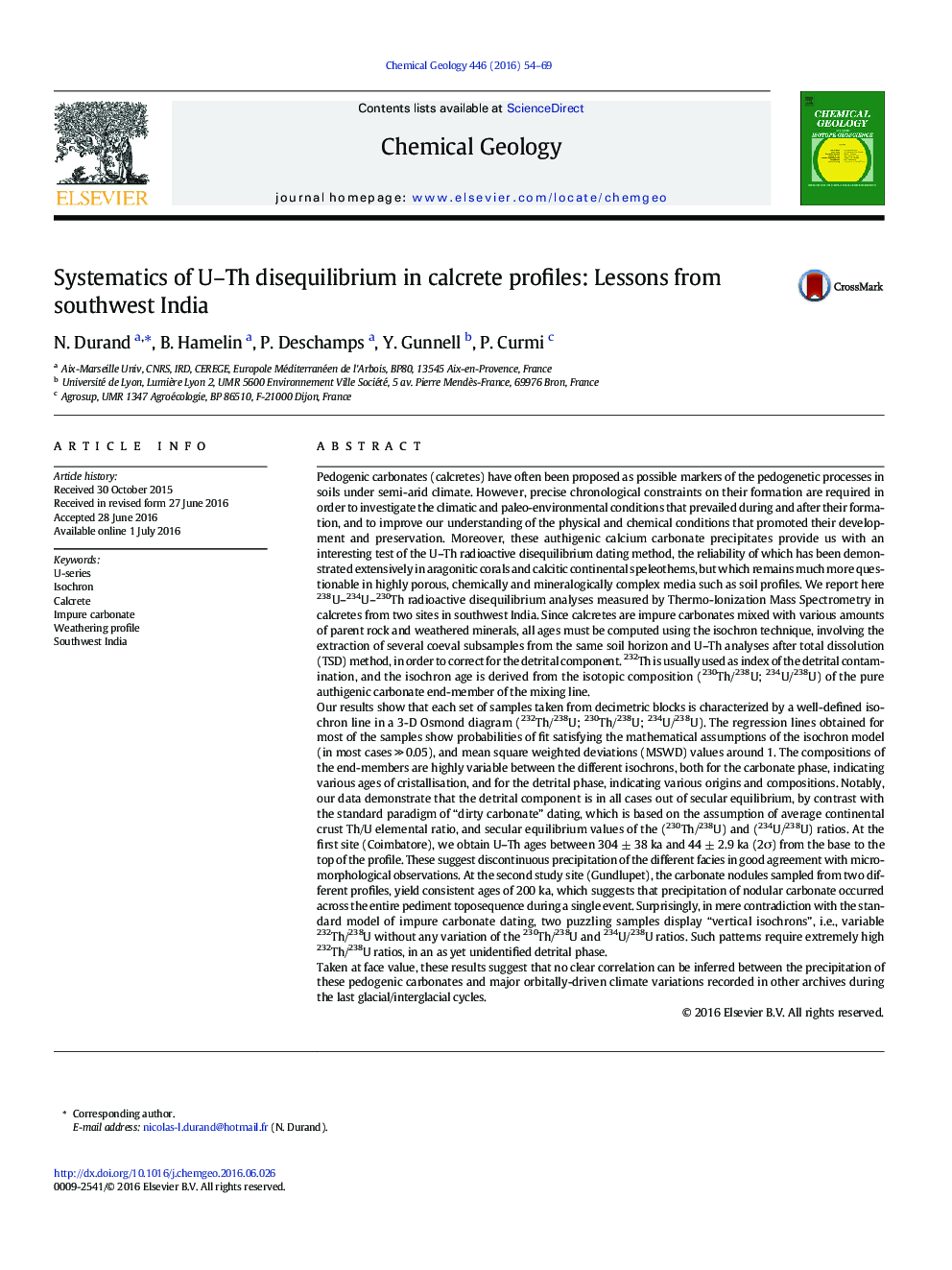| Article ID | Journal | Published Year | Pages | File Type |
|---|---|---|---|---|
| 5782880 | Chemical Geology | 2016 | 16 Pages |
â¢The U-Th isochron technique is applied to date calcrete profiles from south India.â¢Each set of samples provides well-defined isochrons.â¢The detrital component is variable and in all cases out of secular equilibrium.â¢Ages vary between 304 ± 38 ka and 44 ± 2.9 ka (2Ï).â¢There is no clear phasing between calcrete formation and global climate cycles.
Pedogenic carbonates (calcretes) have often been proposed as possible markers of the pedogenetic processes in soils under semi-arid climate. However, precise chronological constraints on their formation are required in order to investigate the climatic and paleo-environmental conditions that prevailed during and after their formation, and to improve our understanding of the physical and chemical conditions that promoted their development and preservation. Moreover, these authigenic calcium carbonate precipitates provide us with an interesting test of the U-Th radioactive disequilibrium dating method, the reliability of which has been demonstrated extensively in aragonitic corals and calcitic continental speleothems, but which remains much more questionable in highly porous, chemically and mineralogically complex media such as soil profiles. We report here 238U-234U-230Th radioactive disequilibrium analyses measured by Thermo-Ionization Mass Spectrometry in calcretes from two sites in southwest India. Since calcretes are impure carbonates mixed with various amounts of parent rock and weathered minerals, all ages must be computed using the isochron technique, involving the extraction of several coeval subsamples from the same soil horizon and U-Th analyses after total dissolution (TSD) method, in order to correct for the detrital component. 232Th is usually used as index of the detrital contamination, and the isochron age is derived from the isotopic composition (230Th/238U; 234U/238U) of the pure authigenic carbonate end-member of the mixing line.Our results show that each set of samples taken from decimetric blocks is characterized by a well-defined isochron line in a 3-D Osmond diagram (232Th/238U; 230Th/238U; 234U/238U). The regression lines obtained for most of the samples show probabilities of fit satisfying the mathematical assumptions of the isochron model (in most cases â«Â 0.05), and mean square weighted deviations (MSWD) values around 1. The compositions of the end-members are highly variable between the different isochrons, both for the carbonate phase, indicating various ages of cristallisation, and for the detrital phase, indicating various origins and compositions. Notably, our data demonstrate that the detrital component is in all cases out of secular equilibrium, by contrast with the standard paradigm of “dirty carbonate” dating, which is based on the assumption of average continental crust Th/U elemental ratio, and secular equilibrium values of the (230Th/238U) and (234U/238U) ratios. At the first site (Coimbatore), we obtain U-Th ages between 304 ± 38 ka and 44 ± 2.9 ka (2Ï) from the base to the top of the profile. These suggest discontinuous precipitation of the different facies in good agreement with micromorphological observations. At the second study site (Gundlupet), the carbonate nodules sampled from two different profiles, yield consistent ages of 200 ka, which suggests that precipitation of nodular carbonate occurred across the entire pediment toposequence during a single event. Surprisingly, in mere contradiction with the standard model of impure carbonate dating, two puzzling samples display “vertical isochrons”, i.e., variable 232Th/238U without any variation of the 230Th/238U and 234U/238U ratios. Such patterns require extremely high 232Th/238U ratios, in an as yet unidentified detrital phase.Taken at face value, these results suggest that no clear correlation can be inferred between the precipitation of these pedogenic carbonates and major orbitally-driven climate variations recorded in other archives during the last glacial/interglacial cycles.
